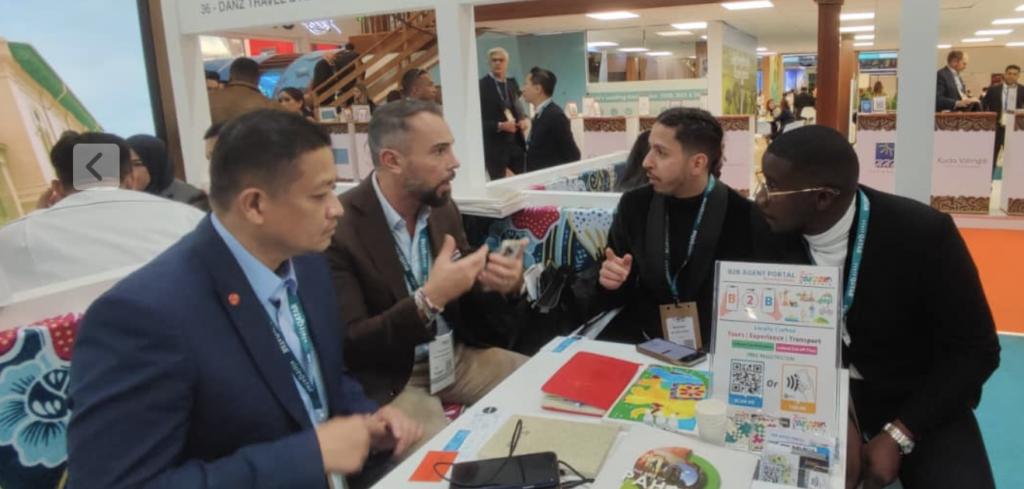Effective Marketing Strategies Before Taking Part In WTM or ITB

In the realm of tour operators seeking to expand their horizons and penetrate long-haul markets, traditional methods have often revolved around attending prestigious travel trade events like World Travel Mart (WTM) in London or the ITB Berlin.
These events hold the promise of international exposure and potential partnerships, yet they come at a considerable cost.
Typically, the journey begins with a significant financial investment. Operators shell out at least RM 20,000, covering expenses for accommodations, flights, and event registration fees. The anticipation runs high as they set foot in these grand showcases of the global travel industry. However, the reality quickly dawns—it’s not quite like a consumer fair.
Over the course of three days, tour operators find themselves stationed at their designated tables within the pavilions. Instead of engaging with a diverse array of walk-in visitors, they often find themselves conversing primarily with their fellow Malaysian counterparts. While there’s certainly nothing inherently wrong with networking within one’s own community, the concern arises when the investment begins to feel inefficient and unproductive. The opportunity cost looms large, especially considering that tour operators can potentially claim up to 50% of these costs under GAMELAN, a Malaysian government initiative aimed at promoting tourism.
Another stark realization emerges amidst the flurry of activity—the majority of buyers perusing the travel trade booths already possess established ground handling agents. In essence, they are well-connected within the industry. This poses a dilemma for tour operators seeking to expand their reach, as the key to growth lies in forging new partnerships, most likely with emerging players in the market.
So, how does one navigate the intricate web of the travel industry to find the right partners and effectively promote their services in long-haul markets?
Here, we propose 10 effective strategies tailored to meet the demands and challenges of expanding into these markets before taking parts in any international travel trade event :
1. Market Research and Segmentation:
- At the heart of every successful venture lies comprehensive market research. Dive deep into the preferences, behaviors, and trends prevalent in your target long-haul markets. For instance, if you’re eyeing the European market, you might uncover a burgeoning interest in sustainable travel practices.
- The insights gleaned from this research will pave the way for effective market segmentation. Tailor your offerings to cater to the specific interests and desires of travelers from your target markets. For example, create eco-friendly tour packages that resonate with environmentally conscious European tourists.
2. Product Customization:
- One size rarely fits all in the travel industry. To truly capture the essence of your target markets, customize your tour packages. Craft experiences that align with the unique preferences of travelers from each long-haul region.
- For example, if you’re setting your sights on the American market, consider offering tailored cultural immersion packages. Include visits to local festivals, art galleries, and culinary experiences to provide an authentic taste of Malaysian culture.
3. Booking System Platform:
- In the digital age, an accessible and user-friendly booking system platform is your gateway to international travelers. Invest in a platform that allows travelers from long-haul markets to seamlessly book your tours online.
- Ensure that your booking system is equipped with multiple payment options to accommodate the diverse needs of your target audience. The goal is to provide convenience and accessibility, particularly for travelers from markets like the United States.
4. Digital Marketing and Social Media:
- Embrace the power of digital marketing to establish a strong online presence in your target markets. Utilize channels such as social media and online advertising to effectively reach your audience.
- Launch compelling digital campaigns that showcase the unique experiences your tours offer. Capture the attention of potential travelers, such as adventurous Europeans, with captivating content that ignites their wanderlust.
5. Right Online Sales Funnel:
- Craft a well-optimized online sales funnel to guide potential customers seamlessly from initial awareness to booking. The key is to create a structured path that nurtures leads throughout their journey.
- For example, if you’re targeting travelers from Russia interested in Malaysian cultural experiences, your sales funnel might include informative blog posts, engaging videos, and personalized email campaigns that educate and entice.
6. Participate Online Global Pitch:
- Adapt to the digital landscape by actively participating in online platforms and events where you can pitch your services to a global audience.
- Consider joining virtual travel trade events that allow you to present your unique offerings to a wide range of international buyers. Leverage the power of online connectivity to expand your reach.
7. Online Business to Business:
- Engage in online B2B networking platforms to connect with potential partners in your target markets. Forge meaningful relationships with travel agencies, influencers, and industry stakeholders.
- Platforms like LinkedIn can serve as valuable tools to establish connections with American travel agents eager to explore Southeast Asia.
8. Online Experience with Lucky Draw Prizes:
- Host immersive online experiences, such as virtual tours or cultural workshops, to actively engage with your target audience. Enhance participation by offering lucky draw prizes as incentives.
- For instance, organize a virtual Malaysian cooking class for European participants, complete with the chance to win a complimentary tour package. This not only fosters engagement but also creates excitement and anticipation.
9. Identify Strategic Partnerships:
- Seek out strategic partnerships that can amplify your reach and influence in your target markets. Collaborate with airlines, travel agencies, and local influencers to strengthen your presence.
- Imagine partnering with a Russian airline to offer discounted flight packages as part of your Russian tour packages. This not only adds value to your offerings but also leverages the established networks of your partners.
10. Collaboration With Other Sellers In Organising Study Trips:
Take the initiative to organize study trips that showcase the unique experiences your tours offer. Invite potential partners and buyers from your target markets to experience firsthand the allure of Malaysia.
– By providing a tangible and immersive experience, you not only captivate your audience but also establish a deeper connection and understanding of your offerings.
These ten strategies serve as a blueprint for tour operators seeking to make their mark in long-haul markets. By adopting these approaches, tour operators can navigate the intricacies of the travel industry, forge meaningful partnerships, and maximize their presence at international travel trade events such as ITB and WTM
